Exploring Blockchain Gaming: Recap of 2023 and Sneak Peek into 2024


In Brief
- The game marketcap experienced a more subdued upward trend compared to BTC throughout the year, with a noticeable uptick towards the end of the year.
- In 2023, only 6% of the total 2,876 games had more than 1,000 active wallet on the blockchain, down from 10% in 2022.
- In 2023, total volume of blockchain games declined from the 2022 peak, but transaction data indicates stability.
- In 2023, game quality is improving and AI is changing the industry. Layer 2 blockchains are evolving but enduring blockchains like Binance still take the lead.
- Market is anticipating top-tier crypto games in 2024, and GambleFi may rise but still face regulatory pressure.
- Crypto gaming based on platform such as Telegram or X(Formerly Twitter) is a new trend.

Blockchain games are considered an important catalyst for the widespread adoption of Web3 technology. Unlike other complex domains, the concept of in-game currencies and game items in traditional games existed long before the emergence of cryptocurrencies in blockchain. This makes blockchain games a more accessible entry point for the general public.
The blockchain game market has experienced a significant decline of 83.8% in annual trading volume (from $20 billion to $3.2 billion) compared to 2022. However, game developers are actively working in anticipation of the upcoming bull market by working on security, scalability and throughput of games and their infrastructure. Developers in this industry have been actively seeking measures to involve more people in the field, including initiating collaborations with and learning from traditional game giants to improve game quality.
As per a16z’s 2024 outlook, the blockchain gaming industry is evolving from a play-to-earn model to a play-and-earn ecosystem by re-emphasizing the importance of playability, which is the essence of gaming.
Moreover, artificial intelligence is revolutionizing various fields, including blockchain gaming, by increasing productivity and unlocking new gaming possibilities.
With these significant developments, we expect blockchain gaming to grow exponentially in the coming years. Our report analyzes the performance data of blockchain gaming in 2023 and discusses potential trends for 2024, providing a valuable reference for the market.
Game Data for 2023: Volume Declined, but Transactions Remain Stable
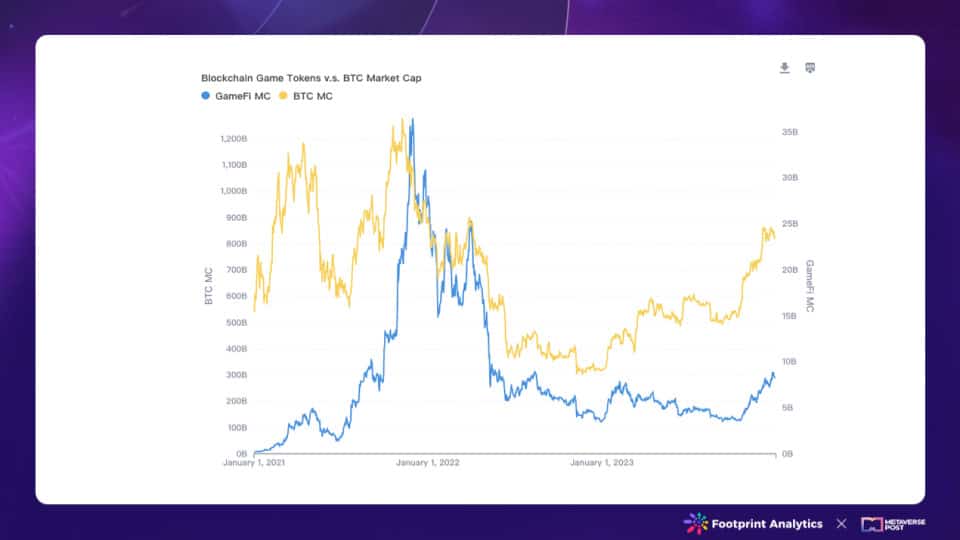
In 2023, Bitcoin (BTC) gradually recovered from the crash in 2022, witnessing a notable increase in its market capitalization, jumping 159% from $319.97 billion to $828.35 billion. Conversely, the game marketcap experienced a more subdued upward trend compared to BTC throughout the year, with a noticeable uptick towards the end of the year.
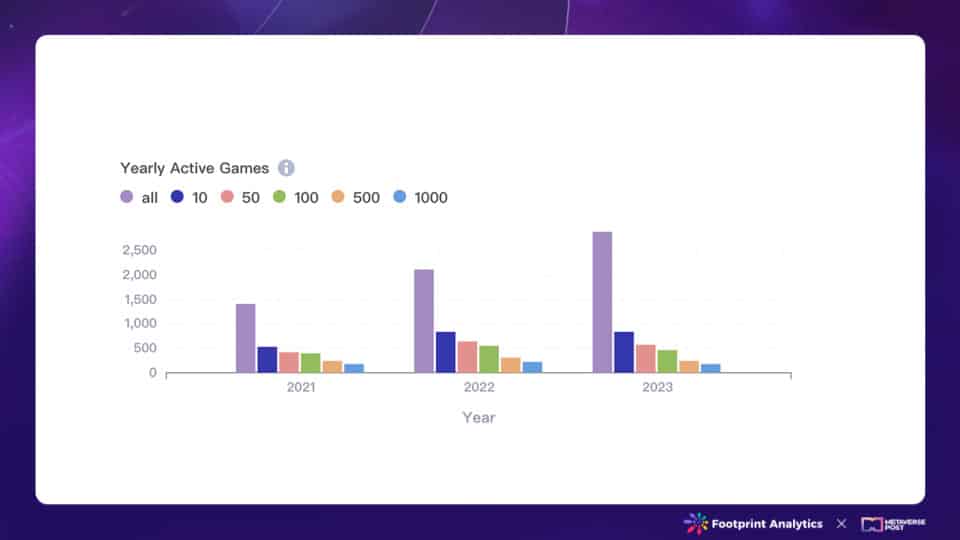
While the number of games continues to grow, user engagement has dropped significantly. In 2023, the number of games on the market jumped from 2,070 to 2,780. However, only 6% of the total 2,876 games had more than 1,000 active wallet on the blockchain, down from 10% in 2022. This suggests that blockchain games have been unable to attract users, with the quality of blockchain games declining compared to the previous year.
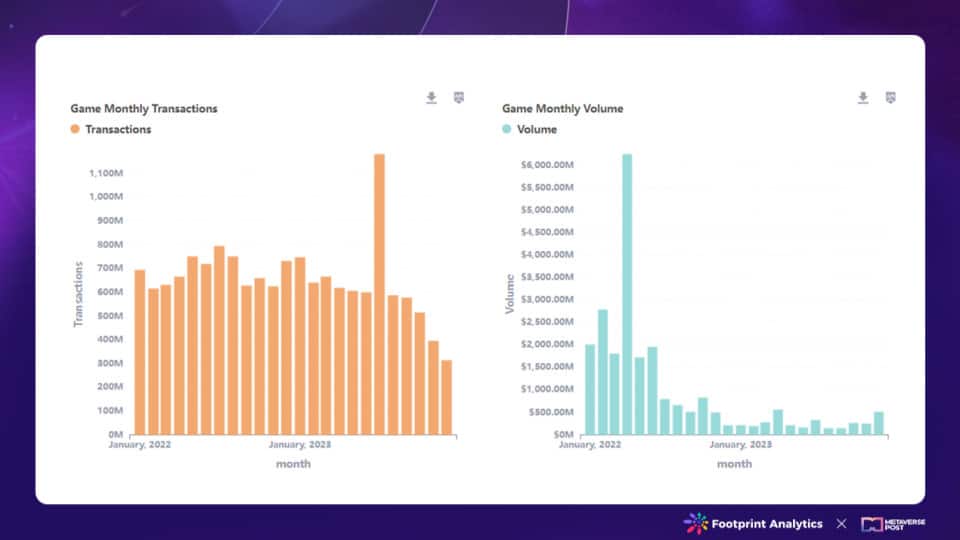
Key industry players are optimizing their architecture, reflecting confidence that the current downturn is temporary.
In 2023, total volume declined from the 2022 peak, but transaction data indicates stability. This trend underscores the industry’s commitment to improving the infrastructure for seamless on-chain operations and improving the user experience. For example, SUI successfully addressed concerns about blockchain throughput by efforts such as SUI 8192, with daily transactions reaching 20 million in July 2023.
We can see that the industry is strategically positioning itself to capitalize on the positive shift in sentiment when it finally occurs.
Highlights of 2023: Games and Blockchains Improving, But On-chain Data Lags
Game Quality is Improving and AI is Changing the Industry
- Play-to-earn is evolving into play-and-earn.
- Web2 studios increasingly embracing Web3 technologies.
- The integration of AI underscores its importance.
According to Footprint Analytics, Web3 games had fewer active players in 2023 than in 2022. However, the overall progress continued with the trend of mass adoption and improving user experience. The industry is moving away from a specific focus on crypto-native players.
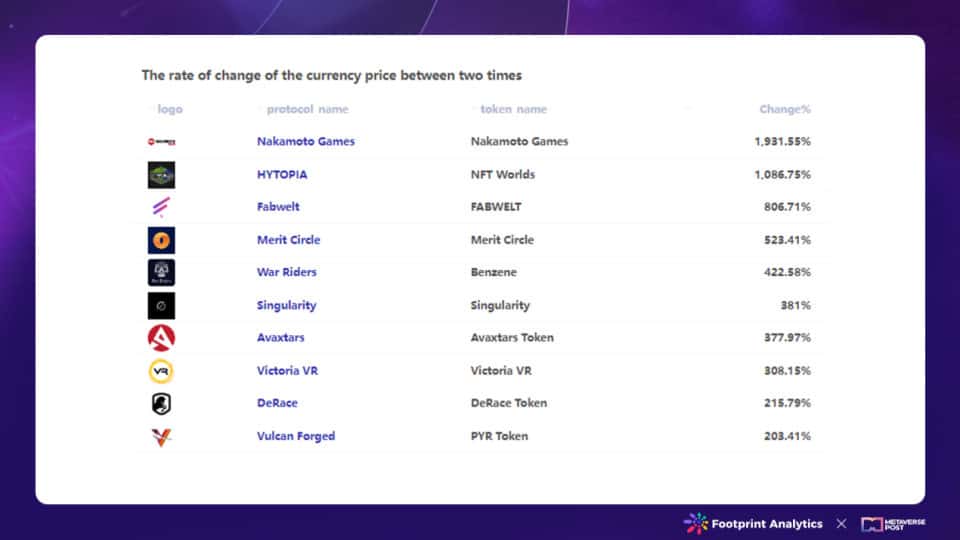
In anticipation of the coming of the bull market, people in the game industry never stopped development. In 2023, four tokens experienced a remarkable increase of over 500%. The top performer was Nakamoto Games, a Web3 gaming hub with more than 200 live games, and its token jumped an impressive 1931.55%.
Other games with token growth in excess of 500% include HYTOPIA, Fabwelt and Merit Circle, which are major gaming platforms, underscoring the viability of projects with robust ecosystems even in challenging market conditions.
An obvious trend in 2023 is that play to earn will become play and earn. It is mainly represented by Web2 companies paying more attention and putting more resources into the blockchain game, using capital and experience to make this new field full of vitality.
There are already successful examples of Web2 companies thriving in the Web3 space. One such example is HYTOPIA, which has seen its token increase by an impressive 1086.75% this year. HYTOPIA has its origins in Mojang Studios’ 2009 sandbox game Minecraft.
Moreover, the renowned AAA game Illuvium has collaborated with numerous mainstream entertainment companies from Web2. We can see the growing interest of Web2 studios to enter the blockchain arena, even traditional gaming giants like Ubisoft and Square Enix are exploring this space.
In 2024, the integration of AI into gaming will become increasingly apparent. AI is disrupting traditional productivity models, enabling small teams to efficiently create high-quality games. Moreover, it has the potential to improve responsiveness to player needs, enabling rapid adjustments to game balance and mechanics by analyzing player data and feedback.
At this early stage, however, the full extent of AI’s impact remains elusive and awaits further exploration by industry builders.
Layer 2 Blockchains are Evolving but Enduring Blockchains like Binance still Take the Lead
- Layer 2 blockchains made notable technical advancements, capturing market attention.
- Enduring blockchains, including Binance, Polygon and Ethereum, still dominate the market, with over 80% of the game count.
2023 has proven to be a significant year for Layer2 blockchains, marked by the rise of notable projects.
In July, SUI demonstrated impressive metrics and proved the power of the Layer2 blockchain. In August, Base made waves with friend.tech, combining social interactions with an entertainment ecosystem. Ronin also gained momentum in November, largely due to its association with Axie Infinity and the launch of Pixels.
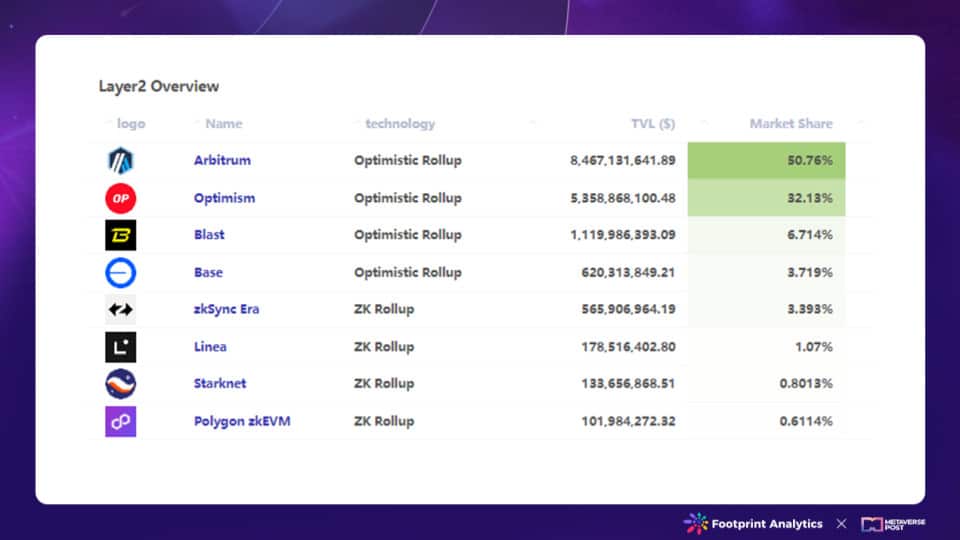
In 2023, rollup technology evolved rapidly, with Arbitrum and Optimism together accounting for an impressive 83% of total value locked (TVL) in Layer 2 as of December 31. Despite this, Layer 2 blockchains designed for gaming are still working to establish a prominent market share. While Optimistic rollups are preferred for DeFi due to their user-friendly nature.
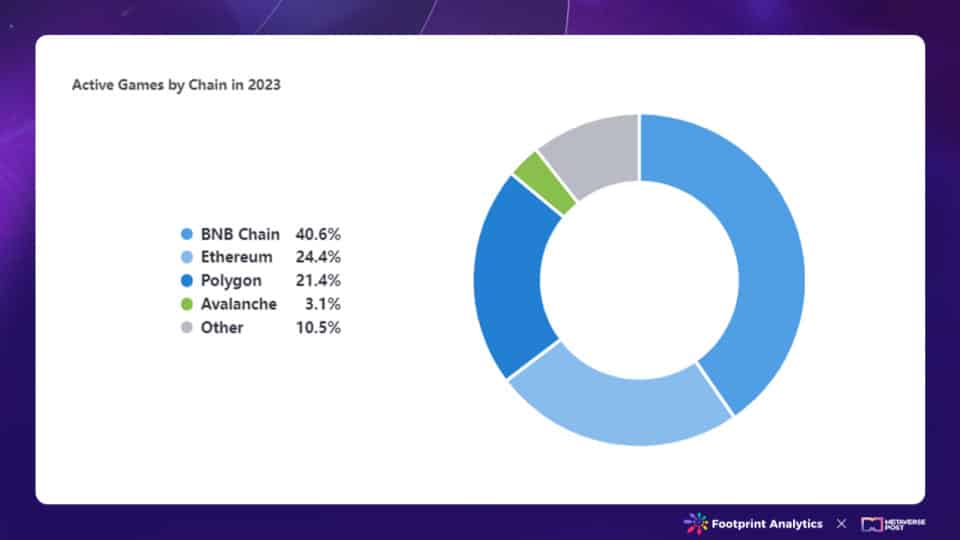
Through analysis, we found that major blockchains like BNB chain, Polygon, Ethereum still comprise 80% of all active games, dominating the current market.
Funding and Investment in 2023
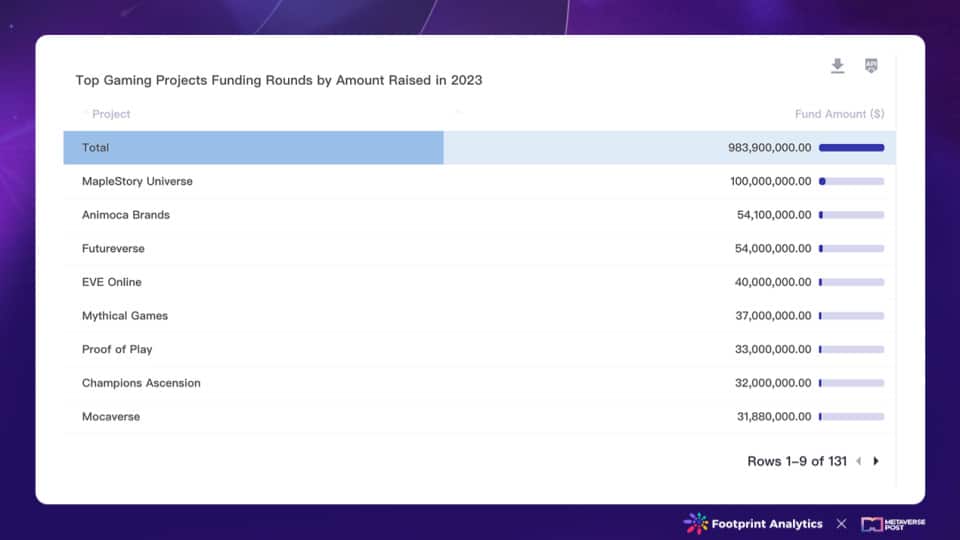
In 2023, the gaming industry experienced a slowdown in investment, influenced by both FTX and regulatory factors. There were a total of 131 funding deals in 2023, amounting to $983.9 million, a significant decline from the impressive $2.6 billion of the previous year. This decline indicates a more cautious approach by investors.
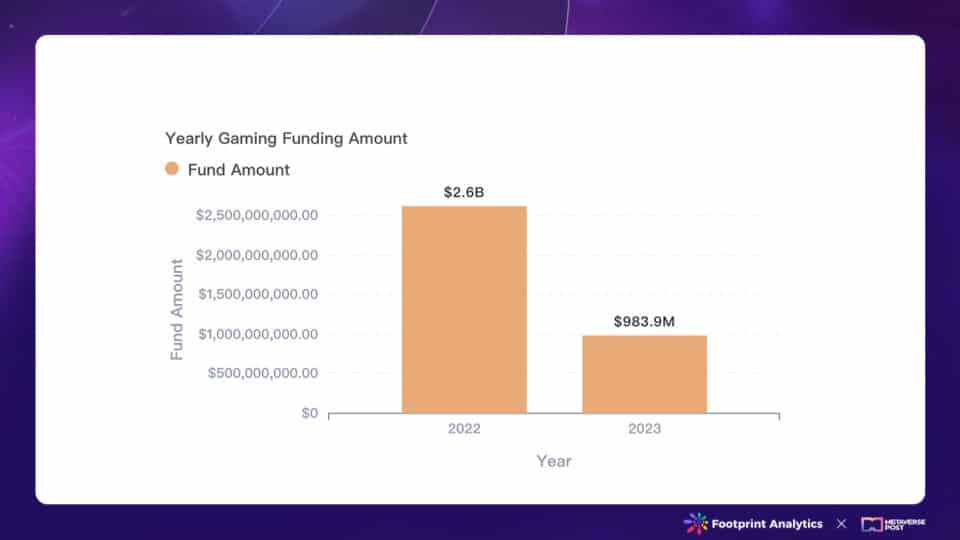
The industry’s top event was from Nexon, a giant in the gaming industry with a current valuation of $27 billion, who invested $100 million in the expansion of its Web3 intellectual property, MapleStory Universe for its operation.
Prospect in 2024: Surge in Top Games and User Migration from Web2 Platforms
- Market is anticipating top-tier crypto games
The blockchain gaming industry is eagerly awaiting the potential arrival of high-quality games, such as AAA games.
Many games should have made significant progress since the funding surge in 2022, as game‘s’ development cycles are typically over 2 years.
The established influence of Web2 giants is positioned to have a significant impact on the blockchain gaming sector as they enter the Web3 space during the upcoming bull market. Game studios with experience creating Web2 games can leverage their expertise to create fun gameplay mechanics for the Web3 game industry, while the integration of blockchain technology promises to increase the transparency, security and opportunities associated with in-game assets and economies.
- GambleFi may rise but still face regulatory pressure

As the presidential election year unfolds and the sports betting industry continues to evolve, platforms like Rollbit are making significant strides, with reported revenue reaching approximately $300 million within a year. The approach of using on-chain destruction to track revenue has attracted attention, although the accuracy of this method remains uncertain.
Despite facing regulatory challenges, GambleFi has become one of the highest-grossing applications in the crypto space, demonstrating the immense potential of blockchain-based gaming and betting platforms.
- Crypto gaming based on platform such as Telegram or X(Formerly Twitter) is a new trend

As the crypto community seeks mass adoption, tapping into the vast user bases of Web2 platforms such as Telegram and Twitter has emerged as a smart approach.
Animoca Brands’ collaboration with The Open Network (TON) blockchain stands out as a significant example in this space. As the primary validator for TON, Animoca Brands is facilitating a transition for existing Web2 users into the realm of Web3 mini-applications. This partnership will not only increase user engagement, but also add significant use-case value to Web3 applications.
As blockchain gaming continues to evolve, leveraging the strengths of established platforms and integrating them with the innovative capabilities of blockchain technology will play a critical role in driving adoption and shaping the future of the industry.
Data Source: Blockchain Game Annual Report of 2023
Footprint Analytics is a blockchain data solutions provider. It leverages cutting-edge AI technology to help analysts, builders, and investors turn blockchain data and combine Web2 data into insights with accessible visualization tools and a powerful multi-chain API across 30+ chains for NFTs, GameFi, and DeFi.
Product Highlights:
- Data API for developers.
- Footprint Growth Analytics (FGA) for GameFi projects.
- Batch download for big-size data fetch.
- View the data dictionary to explore all data sets Footprint provides.
- Check our X post (Footprint_Data) for more product updates.
Disclaimer
In line with the Trust Project guidelines, please note that the information provided on this page is not intended to be and should not be interpreted as legal, tax, investment, financial, or any other form of advice. It is important to only invest what you can afford to lose and to seek independent financial advice if you have any doubts. For further information, we suggest referring to the terms and conditions as well as the help and support pages provided by the issuer or advertiser. MetaversePost is committed to accurate, unbiased reporting, but market conditions are subject to change without notice.

Senior Researcher at Footprint Analytics






















































